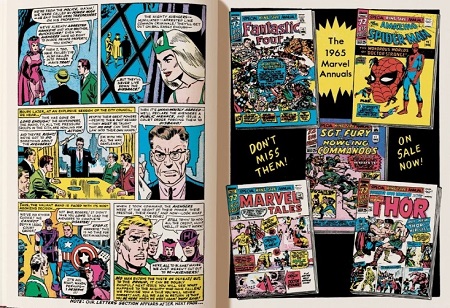MARVEL UNIVERSE: Unveiling the Comics
The Marvel Universe stands as a towering colossus in the entertainment world, a sprawling tapestry of heroes, villains, and cosmic sagas that have captivated generations. The comic book universe started from ink-stained comic books, which evolved into a cultural powerhouse that shapes feature films, television productions, and popular culture. The full comprehension of the Marvel phenomenon emerges through studying the comic book origins, which remain vital in forming its contemporary evolutions.
The Birth of a Universe
Before achieving its present-day name, Marvel Comics operated under the title Timely Comics from 1939 after its founder, Martin Goodman established the enterprise. The company achieved its initial success during its initial phase by introducing its first two characters: the Human Torch and Namor the Sub-Mariner. Groups led by Stan Lee alongside Jack Kirby and Steve Ditko along with other creators established the Marvel Universe we recognize during the 1960s. In November 1961 The Fantastic Four made its first appearance which forever changed the comic book industry. The introduction of the Marvel Age of Comics occurred when Marvel created characters with human flaws that helped distinguish them from their immortal rivals at DC Comics.
Through their exceptional skills in dialogue writing and artwork dynamics, Stan Lee together with Jack Kirby created multiple iconic superheroes, including Spider-Man, X-Men, Iron Man, Thor, and the Hulk. These characters existed beyond basic superhero identities because they experienced teenage rejections as well as scientific hubris alongside familial domestic issues. Readers felt connected to Marvel because of its humanized characters which made the company an important cultural landmark for a generation undergoing social change.
A Web of Interconnection
The Marvel Universe distinguishes itself from other comic brands because the whole MCU connects. Marvel integrates all its stories through shared continuity, which creates effects from one publication that extend into multiple narratives. Spider-Man visits Avengers Tower while major cosmic events like 'The Infinity Gauntlet' transform into complete realities that affect every superhero. Over the decades, Marvel created this intricate web that reflects the complex nature of our world, which displays no stories operating independently from others.
During the 1960s through the 1970s, Marvel Comics fundamentally grew their team roster and they explored relevant contemporary social issues. Through the creative team of Lee and Kirby, the X-Men established itself as a metaphor addressing civil rights by depicting mutants being subjected to bigotry and mistreatment. In 'Fantastic Four' issue 52 from the year 1966, Marvel debuted the superhero named Black Panther who portrayed Wakanda as an African cultural powerhouse aspiring to remodel white media standards about Black empowerment. Captain America depicted the disillusionment of America during the Vietnam War as the country experienced internal fragmentation.
The Cosmic and the Grounded
Marvel tells stories with excellence because it maintains perfect equilibrium between mythology and day-to-day existence. From space, the Silver Surfer flew as he delivered an announcement of Galactus' approach, the giant who destroys planets. The dual responsibilities of Spider-Man keep Peter Parker from making his monthly rent payments. The combination of extravagant cosmic events and human-scale personal journeys makes readers stay engaged with the story. In the 1991 story by Jim Starlin called 'Infinity Gauntlet,' Thanos eliminates half of all living beings with a single snap but the emotional heart rests in the heroes' frantic quest to recover their loved ones.
The early part of the twenty-first century proved to be groundbreaking for Marvel. Frank Miller added gritty noir elements to Daredevil comic books at the same time Chris Claremont spent multiple decades writing about identity problems and traumatic experiences in X-Men comics. Marvel Entertainment developed its blockbuster event creation abilities through two seminal productions, 'Secret Wars' from 1984 and 'Civil War' from 2006 that showed heroes engaging in moral conflicts echoing contemporary social tensions.
Evolution Through Crisis
The Marvel brand faced various formidable difficulties during its time. In the 1990s comic book industry slump, Marvel Comics faced bankruptcy to the extent that it needed to sell the film rights for Spider-Man and X-Men characters. Yet, this adversity spurred the reinvention. A new generation of readers discovered updated versions of Marvel classics during the 2000s through titles such as ‘Ultimate Spider-Man’ and ‘The Ultimates.’ The Marvel comic universe received new direction from writers Brian Michael Bendis, Mark Millar, and Ed Brubaker, and such artists as Jim Lee and Alex Ross brought outstanding visual value to the stories.
The MCU entered the world through its initial release of 'Iron Man' in 2008 due to comic book foundations. Marvel Studios executive Kevin Feige derived all his inspiration for Tony Stark's humor Captain America's optimistic hero and Thor's epic characteristics from the original comic creators Lee and Kirby and subsequent authors. The comics stand as the vital substance behind this creation since Jonathan Hickman's 'House of X' comics from 2019 reestablished the X-Men character for the contemporary readers.
A Legacy Unbound
The Marvel Universe exceeds its basic definition of comic books through its transformation into mythological narratives during contemporary times. Although movie adaptations and video games portray their heroes today, the comics retain their central role as the spiritual essence. Since its inception eighty years ago, Marvel has narrated human success and failure through various stories of powered superheroes. Vertically and horizontally across all universes, the messages from Spider-Man with great power come from great responsibility and the X-Men's acceptance of the battles remains relevant.
Marvel Comics develops through the adoption of diverse storytelling approaches and revolutionary narratives. Also, new Marvel brand writers Ta-Nehisi Coates and G. Willow Wilson have enriched the cultural base of the comics by creating heroes such as Kamala Khan for our globalized society. The digital platforms provide easy access to Marvel stories which makes the Marvel Universe persist as a dynamic ongoing entity for all the readers.
Conclusion
The Marvel Universe unveiled through its comics, is a testament to the enduring power of storytelling. From its 1960s origins to its modern evolution, it mirrors humanity’s struggles, triumphs, and dreams. Through flawed heroes, cosmic epics, and a web of interconnected tales, Marvel has transcended ink and paper to become a global mythology. As it embraces diverse voices and digital frontiers, its legacy remains boundless, proving that the most timeless narratives are those that reflect our shared human spirit.
🍪 Do you like Cookies?
We use cookies to ensure you get the best experience on our website. Read more...






